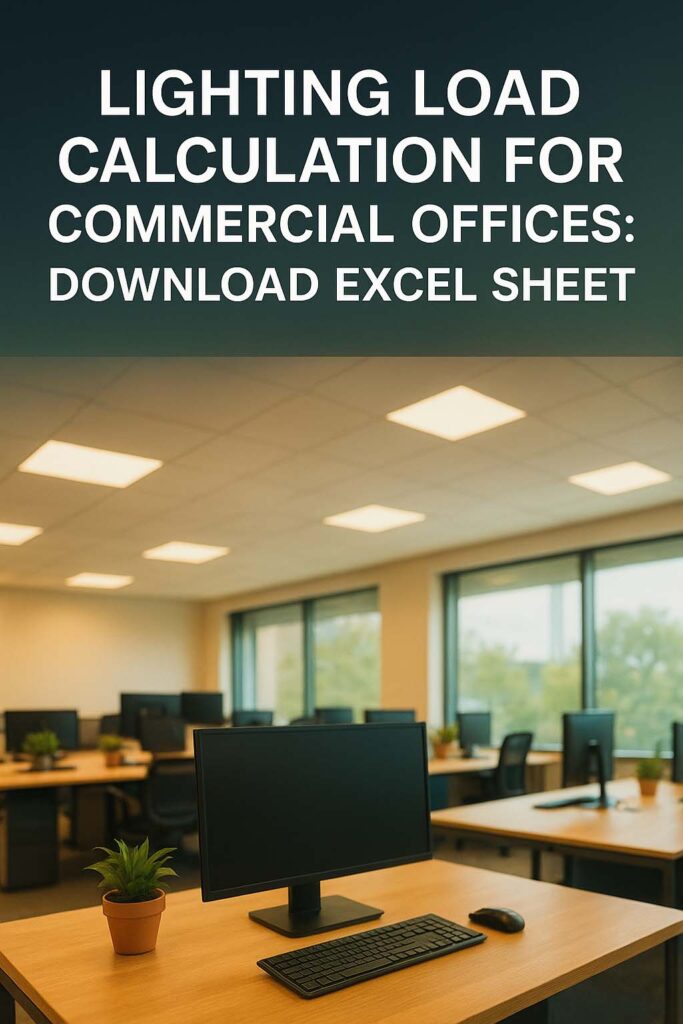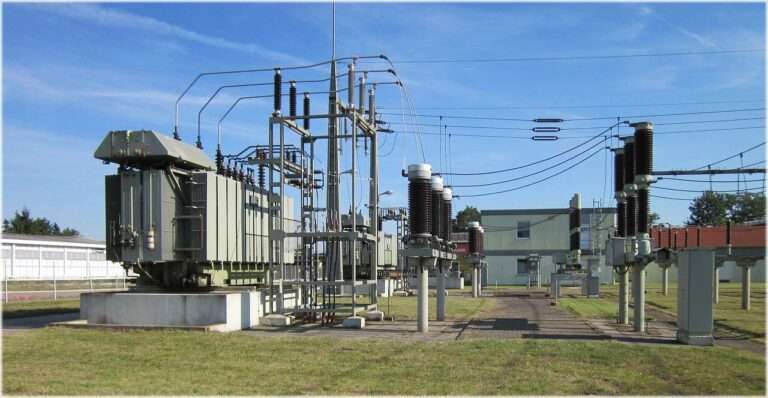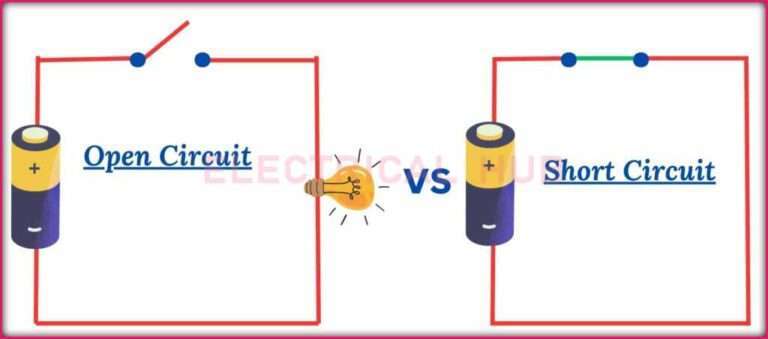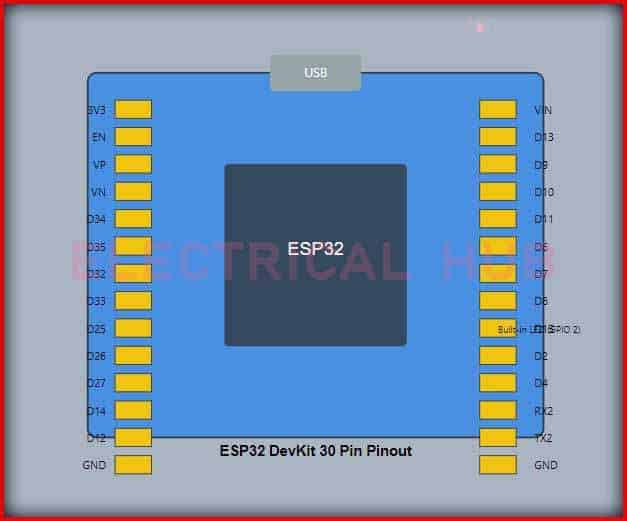Lighting Load Calculation for Commercial Offices: Download Excel Sheet
Lighting plays a central role in every commercial office. It not only ensures a productive and comfortable working environment but also represents a significant portion of the total electrical load. Engineers and facility managers must calculate the lighting load accurately to avoid under-designing or over-sizing the electrical system. If you are planning a new office project or an energy audit, a structured approach to Lighting Load Calculation for Commercial Offices is essential.

To make the process easier, I have prepared a ready-to-use Excel sheet that simplifies the entire process. You can also check my detailed guide on Electrical Load Estimation which provides broader insights into overall load calculations for buildings.
Lighting load calculation requires understanding three things: the type of lamps, their wattage, and the operating hours. For commercial offices, additional considerations include lighting layouts, efficiency requirements, and compliance with international energy codes. Unlike residential buildings, where lighting demand is relatively low, office buildings operate for extended hours and host a large number of occupants, which makes load planning even more critical.
The cost of lighting not only affects the initial electrical design but also contributes to long-term energy bills. Inaccurate calculation often results in poor power factor, higher demand charges, and inefficient use of electrical infrastructure. That is why using a step-by-step methodology and supporting tools like the provided Excel sheet ensures accuracy, reliability, and compliance.
Key Takeaways
- Accurate Lighting Load Calculation for Commercial Offices improves safety, efficiency, and cost savings.
- Parameters like lamp wattage, number of fittings, operating hours, and utilization factor must be considered.
- A downloadable Excel sheet is available to simplify calculations.
- Correct estimation helps in transformer sizing, circuit breaker selection, and overall Electrical Load Estimation for residential projects.
Importance of Lighting Load Calculation for Commercial Offices
In a commercial office, lighting accounts for 25–40% of total electricity consumption. Without proper load calculation, the entire electrical design may be compromised. Too low an estimate can lead to frequent tripping of breakers and insufficient illumination, while overestimation results in wasted investment in oversized equipment. Accurate calculations support:
- Energy efficiency compliance with standards like IEC, NEC, and ASHRAE.
- Correct design of lighting circuits, switchgear, and distribution boards.
- Better budgeting for both capital cost and recurring utility bills.
- Enhanced comfort and productivity by maintaining required lux levels in workspaces.
Use our online tool Power Factor Correction Capacitor Calculator – Complete Technical Guide
Basic Formula for Lighting Load Calculation
The general formula used in Lighting Load Calculation for Commercial Offices is:
Lighting Load (W) = Number of Fixtures × Wattage per Fixture × Utilization Factor × Maintenance Factor
- Number of Fixtures: The total count of lamps or luminaires installed.
- Wattage per Fixture: Rated power of the lamp, typically 18W, 36W, or LED equivalents.
- Utilization Factor (UF): Ratio of actual lumen reaching the working plane to the total lumen emitted.
- Maintenance Factor (MF): Accounts for lumen depreciation and dirt accumulation over time.
For practical design, an additional diversity factor is often considered. This assumes not all lights are used simultaneously at full capacity.
Example Lighting Load Calculation for an Office
Consider a medium-sized office with the following details:
| Room Type | Number of Fixtures | Wattage per Fixture (W) | UF | MF | Calculated Load (W) |
|---|---|---|---|---|---|
| Open Office Area | 50 | 36 | 0.8 | 0.9 | 1296 |
| Meeting Rooms | 20 | 18 | 0.8 | 0.9 | 259 |
| Corridors | 15 | 18 | 0.75 | 0.9 | 182 |
| Reception Area | 10 | 24 | 0.8 | 0.9 | 173 |
Total Lighting Load = 1910 W (≈ 2 kW)
This load can then be used in the Excel sheet to automatically calculate demand factors, connected load, and kVA rating.
Know more about Off-Grid Solar System Design Guide for Remote Areas
Demand Factor in Commercial Lighting
Demand factor is a critical component in office load design. Not every light is switched on at all times, especially in meeting rooms, corridors, or lobbies. National codes often suggest demand factors between 0.8 to 0.9 for commercial offices. Applying this factor reduces the design load and ensures economic system sizing without compromising safety.
For example, if the connected load is 10 kW, applying a demand factor of 0.85 results in a design load of 8.5 kW. This helps in selecting appropriately sized breakers and feeders.
Standards and Guidelines for Lighting in Offices
Several international standards guide Lighting Load Calculation for Commercial Offices:
- IEC 60364: Covers general electrical installations.
- ASHRAE 90.1: Provides lighting power density (LPD) limits for energy efficiency.
- NEC (National Electrical Code): Defines rules for lighting circuits and protection.
- CIBSE Guide: Offers lux level recommendations for office spaces.
Typical recommended illuminance levels are:
| Area | Recommended Lux Level |
|---|---|
| General Office | 300–500 lux |
| Meeting Rooms | 300–400 lux |
| Reception | 200–300 lux |
| Corridors | 100–150 lux |
Using these lux levels, designers can back-calculate the number of fixtures required and then compute the total load.
Know more about Short Circuit Calculation Methods: IEC vs ANSI
Benefits of Using Excel for Lighting Load Calculation
Manual calculation often leads to mistakes and consumes time. An Excel sheet for Lighting Load Calculation for Commercial Offices provides:
- Auto-calculation of load based on inputs.
- Flexibility to adjust wattage, fixture count, UF, and MF.
- Quick recalculations for design changes.
- Summarized reports for submission to consultants or utility companies.
This Excel tool is especially useful for design engineers, electrical contractors, and facility managers who want reliable results in minimal time.
Integration with Electrical Load Estimation
Lighting load is just one part of the total electrical demand. Offices also include HVAC systems, plug loads, elevators, and other utilities. Once you have determined the lighting load, you can integrate it with total building demand using my comprehensive Electrical Load Estimation guide. This ensures that your transformer, panel boards, and generators are sized correctly for all connected loads.
Know more about Transformer Cooling Methods: ONAN, ONAF, OFAF & More
Energy Efficiency Considerations
Modern offices are shifting from traditional fluorescent lamps to LEDs due to their higher efficacy and longer lifespan. An LED consumes 50–70% less energy compared to conventional lamps. During Lighting Load Calculation for Commercial Offices, it is advisable to use LED-based designs to reduce both connected and operating loads.
Furthermore, daylight integration, motion sensors, and automatic dimming systems can reduce unnecessary usage. By applying such energy-saving techniques, the demand factor can be optimized further, leading to significant cost savings.
Common Mistakes in Lighting Load Calculation
Even experienced designers can make errors while estimating loads. Common mistakes include:
- Ignoring maintenance factor, leading to over-brightness in the early years and poor illumination later.
- Not applying demand factor, which results in oversized systems.
- Failing to consider lamp depreciation.
- Overlooking energy code requirements for lighting power density.
By avoiding these mistakes and using a structured Excel-based tool, professionals can achieve both compliance and efficiency.
Know more about Star Delta Transformer Fault Current Distribution Explained
Conclusion
Accurate Lighting Load Calculation for Commercial Offices is a cornerstone of modern electrical design. It ensures safe operation, compliance with standards, and long-term energy efficiency. Using the downloadable Excel sheet simplifies the process and reduces the risk of errors. For complete system design, lighting load must always be integrated with other building services through proper Electrical Load Estimation methods. By adopting structured calculations, applying demand factors, and considering efficiency improvements, office projects can achieve both technical reliability and cost savings.
Follow Us on Social:
Subscribe our Newsletter on Electrical Insights for latest updates from Electrical Engineering Hub
#LightingLoadCalculation, #CommercialOfficeLighting, #OfficeElectricalDesign, #LightingDesignCalculation, #ElectricalLoadCalculation, #BuildingLightingPlan, #LightingLoadExcel, #CommercialLightingDesign, #LightingLoadEstimator, #ElectricalEngineeringTools, #OfficeLightingLoad, #LightingLoadCalculator, #BuildingElectricalDesign, #LightingLoadSpreadsheet, #ElectricalDesignCalculation






